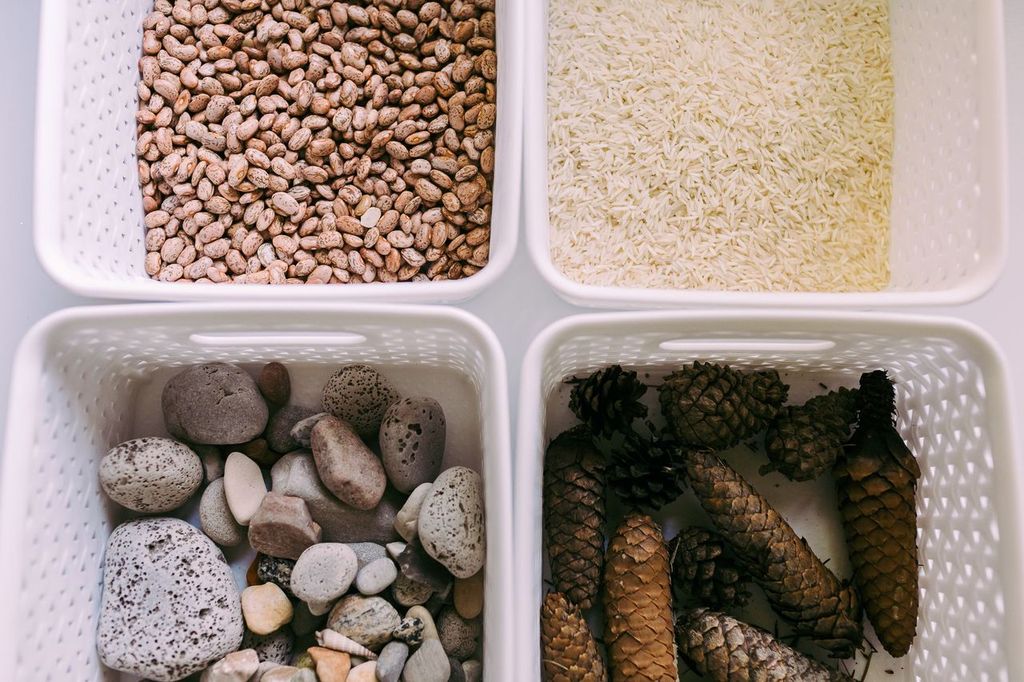Engage your child's senses with an easy DIY Sensory Table - a fun and educational way to keep them entertained all day long!
We are here today with a quick way to keep your littles busy and engaged all day long with this indoor activity idea: a DIY Sensory Table! Firstly, when we provide our littles with sensory play opportunities, we are helping them explore and understand the world through their senses. Sensory play aids our children in so many parts of their development such as cognitive growth, language skills, fine motor development, emotional regulation, social interaction, and creativity. Essentially, it’s providing a multi-sensory learning experience that supports overall development AND keeps them having fun and occupied. So, can we get started already?!

DIY Sensory Table Indoor Activity Idea
What You’ll Need:
- Some type of large semi shallow container (a plastic storage bin works perfectly!)
- A sturdy table or stand (or you can simply place the bin on the floor or in the grass outside)
- A variety of sensory materials (we’ve got some fun ideas below!)
- Small scoops, spoons, cups, and containers for pouring and sorting (you can even include child safe tools to pick items up with such as tongs)
Step-by-Step Guide to Creating Your DIY Sensory Table
-
Choose Your Container:
The first step is to select a large, somewhat shallow container (basically something your children can reach into easily). Plastic storage bins are ideal because they're durable, easy to clean, and just the right size for little hands to explore this DIY sensory table.

-
Set Up the Table:
Place the container on a sturdy table, stand, the floor, or grass!
Spreading out a mat or towel to catch any spills and keep the area tidy is never a bad idea. Having the sensory table set up outside is also a fun way to get outdoor time, avoid indoor messes, and you can even add some outdoor elements to the sensory table itself!
-
Select Your Sensory Materials:
Now comes the fun part—choosing your sensory materials! The possibilities are endless, but here are some of our favorites:
- Dry Materials: Rice, beans, pasta, sand, or birdseed
- Wet Materials: Water, soapy bubbles, or water beads
- Tactile Materials: Play dough, kinetic sand, or slime
- Nature Materials: Leaves, pinecones, pebbles, or shells
-Miscellaneous: Items that match the season or something your child is interested in learning more about. For example, in the Fall, adding leaves, in the Winter, use packing peanuts as “snow”, etc.

-
Add Tools for Exploration:
Enhance the sensory experience with a variety of tools. Think scoops, spoons, measuring cups, funnels, and strainers. Small toys, figurines, and themed items can add an extra layer of imaginative play!
-
Theme Your Sensory Table:
Creating themed sensory tables can make the experience even more magical. It’s a great time to bond with your kiddo and get them involved with choosing the theme. Here are some theme ideas to get you started:
- Ocean Theme: Blue water beads, seashells, plastic sea creatures, and sand
- Construction Theme: Kinetic sand, small construction vehicles, and rocks
- Farm Theme: Dried corn, toy farm animals, straw or hay, and miniature fences
-
Encourage Exploration:
As your kiddo is exploring the sensory table, ask those open-ended/inquiry based questions like "What does this feel like?" or "Can you find all the blue items?" Encourage them to create their own games and stories, fostering creativity and independent play.

Benefits of Sensory Play
DIY sensory tables are not just fun—they’re incredibly beneficial for your child’s development:
- Fine Motor Skills:
Scooping, pouring, and manipulating small objects help strengthen hand muscles and coordination.
- Cognitive Development:
Sorting, counting, and exploring different textures enhance problem-solving skills and cognitive growth.
- Language Skills:
Describing what they feel and see helps build vocabulary and communication skills.
- Social Skills:
Playing with others at a sensory table encourages sharing, cooperation, and turn-taking.
Clean-Up Tips
As our children can attest to, some of the most fun things can get messy. Here are some tips for easy clean-up:
- Place a plastic tablecloth or mat under the table to catch spills.
- Use a small handheld vacuum or broom to quickly clean up dry materials.
- For wet materials, keep a towel handy for any drips or splashes.
Your Turn!
Creating your own DIY sensory table at home is a simple but engaging indoor activity idea to bring excitement into your child’s day. We can’t wait to see what you come up with!
For a chance to be featured, share your creations with us on social media using #PlaygroundPressKids. We can't wait to see your sensational DIY sensory tables!

